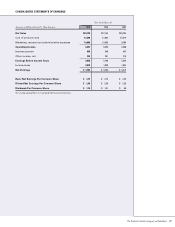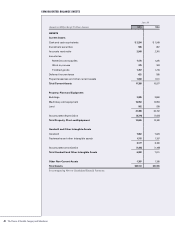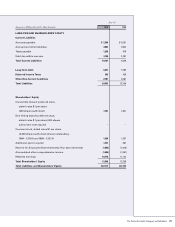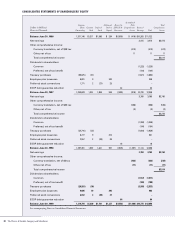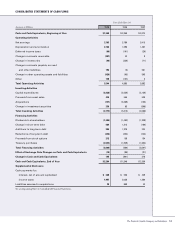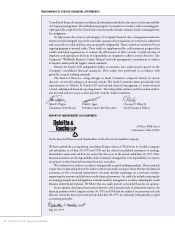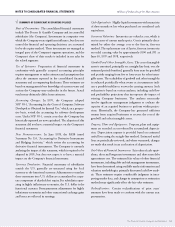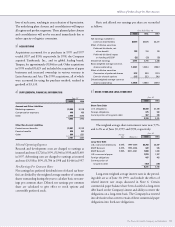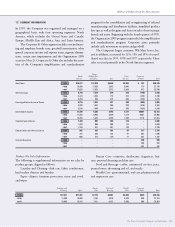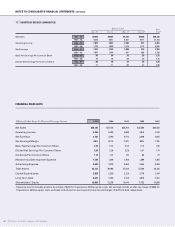Proctor and Gamble 1999 Annual Report Download - page 38
Download and view the complete annual report
Please find page 38 of the 1999 Proctor and Gamble annual report below. You can navigate through the pages in the report by either clicking on the pages listed below, or by using the keyword search tool below to find specific information within the annual report.
34
The Procter & Gamble Company and Subsidiaries
NOTES TO CONSOLIDATED FINANCIAL STATEMENTS (CONTINUED)
2ORGANIZATION 2005
On June 9, 1999, the Company announced an Organization
2005 program that is an integral part of the broader 2005 initia-
tive, which includes a realignment of the organization structure,
work processes and culture designed to accelerate growth by
streamlining management decision-making, manufacturing and
other work processes to increase the Company’s ability to inno-
vate and bring initiatives to global markets more quickly.
In connection with this program, effective July 1, 1999,
the Company moved from a geographic region structure to
product-based Global Business Units (GBUs), which will be
responsible for all strategic, manufacturing and sourcing activ-
ities. The GBU structure will be complemented by eight
Market Development Organizations (MDOs) intended to
maximize the business potential of the entire product portfolio
in each local market. Organization 2005 will also consolidate,
standardize and streamline essential business services such as
accounting, employee benefits, order management and infor-
mation technology services, by creating a Global Business
Services organization. In order to implement the program’s
structural changes and achieve the benefits of faster growth, the
Company also needs to make a number of structural and
organizational changes to both its administrative and manu-
facturing operations. This will result in the implementation
of standardized global manufacturing facilities and processes
designed to streamline its global manufacturing capabilities.
The costs resulting from Organization 2005 include those
related to separation and relocation of employees, streamlining
manufacturing capabilities, including consolidation and
closure of certain manufacturing facilities, and other charges.
Total charges related to Organization 2005 are expected to
approximate $2.6 billion ($1.9 billion after tax) over six years.
The Company recorded charges totaling $481 ($385 after
tax) for the year ended June 30, 1999, and expects to record
additional charges under this program totaling $1.5 billion
($1.0 billion after tax) during the next two years, approximately
two-thirds of which will be incurred in fiscal 2000. The balance
of the charges related to Organization 2005 are not expected to
materially affect any single year, and savings are expected to off-
set the charges. Given the scope, magnitude and term of this
program, the expected timing and amount of costs and savings
are based on management’s judgment. Accordingly, such esti-
mates could change as future events evolve.
For 1999, the before-tax charges consisted of the following:
Cash Amount
Spent Charged
Total During Against Ending
Charges Period Assets Reserves
Employee separations $ 45 $(10) $ – $35
Asset write-downs 217 – (217) –
Accelerated depreciation 208 – (208) –
Other 11 (2) – 9
481 (12) (425) 44
The Organization 2005 charges are included in the
Company’s cost of products sold ($443) and in marketing,
research and administrative expenses ($38), and are included in
Corporate & Other for segment reporting.
The employee separation charges in 1999 relate to sever-
ance packages for approximately 400 people, primarily
administrative employees in Asia, Europe, Middle East and
Africa. The predominantly voluntary packages are formula-
driven based on salary levels and past service and were charged
to earnings upon acceptance of the package. The Organization
2005 program will result in approximately 9,000 additional
employee separations over the next two years.
The asset write-downs relate primarily to manufacturing
assets that, based on a shift in global strategy resulting from
Organization 2005, as well as demand trends below expectation,
now are expected to operate at levels significantly below their
capacity for an extended period of time. Because the projected
cash flows from such assets over their remaining useful lives are
less than the current carrying values, the assets were written down
to their estimated fair values as determined using discounted cash
flows. The balance of the asset write-downs relate to “assets held
for disposal” and represent excess capacity that is in the process of
being removed from service and disposed. Such assets were writ-
ten down to the lower of their current carrying basis or
amounts expected to be realized upon disposal, net of related
disposal costs. Such disposal costs are not expected to be sig-
nificant. The disposition of these assets, which do not have a
significant remaining carrying value, will be completed during
the first quarter of fiscal 2000, primarily through abandonment.
The asset write-downs charged to earnings in 1999 will not have
a significant impact on future depreciation charges.
The accelerated depreciation relates to long-lived produc-
tive assets that will be taken out of service prior to the end of
their normal service period due to manufacturing consolida-
tions, technology standardization and closures that will occur
primarily over the next three years, resulting from Organization
2005. The Company’s policy is to change the estimated useful





